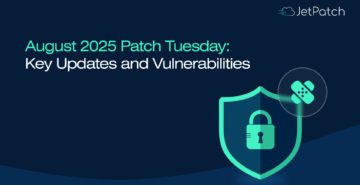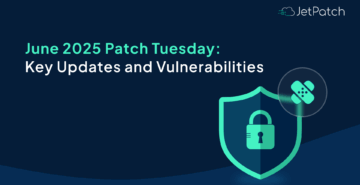The July 2025 Microsoft Patch Tuesday marks a crucial update cycle, addressing 130 Common Vulnerabilities and Exposures (CVEs) across a wide range of Microsoft products and services, including Windows OS, Office, SharePoint, Hyper-V, BitLocker, and more.
This follows the June 2025 patch tuesday release, which included 70 CVEs, with 8 classified as critical, covering a wide spectrum of vulnerabilities.
Compared to June, the July patch tuesday rollout reflects a significantly broader remediation scope nearly double in volume, reinforcing the need for proactive and policy-based patch management.
With each ms patch tuesday, IT and security teams must weigh patch urgency against operational risk.
Let’s uncover what June patch tuesday release has in store for us.
Key CVEs Addressed in Microsoft July Patch Tuesday Updates
The July 2025 Patch Tuesday rollout corrected 130 vulnerabilities, including several critical flaws across Microsoft’s widely used platforms and services. While the July release does not include any officially reported zero-day vulnerabilities, it introduces notable security fixes that demand attention from enterprise IT and security teams..
Comprehensive Vulnerability Assessment
This section provides a detailed look at the CVEs addressed in this month’s patch tuesday updates, categorized by their nature and potential impact:
- Virtual Hard Disk (VHDX): 4 vulnerabilities highlight persistent risks in virtual storage components. These are particularly important for virtualized and cloud-hosted environments where VHDX is a core component of storage architecture.
- Windows Kernel: 4 vulnerabilities reinforce the importance of hardening the core OS. As the foundational layer of Windows, any compromise here could lead to system-wide instability or privilege abuse.
- Microsoft Input Method Editor (IME): 3 vulnerabilities underscore security gaps in localized or multi-language input systems, which could potentially be abused for executing unauthorized commands or escalating privileges.
- Windows SSDP Service: 3 vulnerabilities signal risks in device discovery services. Left unpatched, these could lead to information disclosure or remote access vectors in distributed environments.
- Microsoft Office SharePoint: 3 vulnerabilities reflect the continued targeting of collaborative platforms. These flaws could allow remote attackers to access or manipulate shared enterprise data.
- Microsoft Graphics Component: 3 vulnerabilities demonstrate risks in rendering and image processing components. Such issues could allow attackers to exploit display layers for code execution or denial of service.
- SQL Server: 3 vulnerabilities within a core enterprise database product emphasize the need for secure data layer protections, especially for applications with direct database exposure.
- Microsoft Brokering File System: 3 vulnerabilities point to backend file-sharing mechanisms that, if exploited, could lead to unauthorized access or manipulation of enterprise data.
- Microsoft Office Word: 3 vulnerabilities call attention to client-side document-based attacks. These are especially dangerous in phishing scenarios where weaponized documents are delivered to end users.
- Role: Windows Hyper-V: 3 vulnerabilities impact virtualization infrastructure. These flaws are critical for businesses that rely on Hyper-V for isolated environments, as successful exploits could lead to breakout attacks or host compromise.
| Vulnerability Type | Count |
| Virtual Hard Disk (VHDX) | 4 |
| Windows Kernel | 4 |
| Microsoft Input Method Editor (IME) | 3 |
| Windows SSDP Service | 3 |
| Microsoft Office SharePoint | 3 |
| Microsoft Graphics Component | 3 |
| SQL Server | 3 |
| Microsoft Brokering File System | 3 |
| Microsoft Office Word | 3 |
| Role: Windows Hyper-V | 3 |
Implementing Microsoft June 2025 Patch Tuesday Updates
Organizations must prioritize timely and automated patch deployment for systems running Windows Server, SharePoint, SQL Server, Hyper-V, and Office applications. These
Key steps include:
1. Automate Patch Workflows Across Multi-OS Environments
Use centralized patch management platforms like JetPatch to automate patch rollouts across Windows and Linux endpoints. This reduces manual workload, eliminates inconsistency, and ensures faster time to remediation for the 130 vulnerabilities addressed in this microsoft patch tuesday release.t.
2. Prioritize CVEs Marked as ‘Exploitation More Likely’
Target critical vulnerabilities first, especially those labeled “Exploitation More Likely” such as those affecting Windows Kerberos, BitLocker, and SharePoint. With JetPatch’s predictive patching engine, teams can simulate the impact of updates before applying them, minimizing disruption while staying protected.
3. Maintain Compliance with Real-Time Visibility and Policy Enforcement
Ensure continuous compliance by enforcing SLA-aligned remediation windows and monitoring progress in real time. JetPatch enables visibility into every endpoint’s patch state, helping teams adhere to internal security policies and external regulations, a crucial need in light of this Windows patch tuesday volume.nd protected.
Organizations should review patch policies now to avoid cascading risks in the coming weeks.
JetPatch can help enable real-time monitoring, rollback if needed, and audit-ready reporting to meet regulatory or internal governance standards.
Conclusion
This July 2025 update cycle targeted 130 key vulnerabilities, including high-impact categories like remote code execution, elevation of privilege, and spoofing.
The CVEs affected essential services such as Windows Server, SharePoint, SQL Server, BitLocker, Hyper-V, and Office, highlighting the necessity for automated, policy-based patch management.
JetPatch can enhance IT security efficiency through the complete automation of the patch management lifecycle, from assessing CVEs to testing and deploying patches across distributed environments.
This end-to-end orchestration not only reduces exposure to known vulnerabilities but also improves operational consistency and compliance adherence.
For more information, contact us to schedule a personalized demo.


